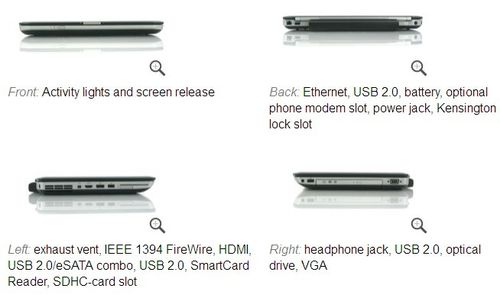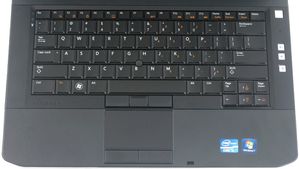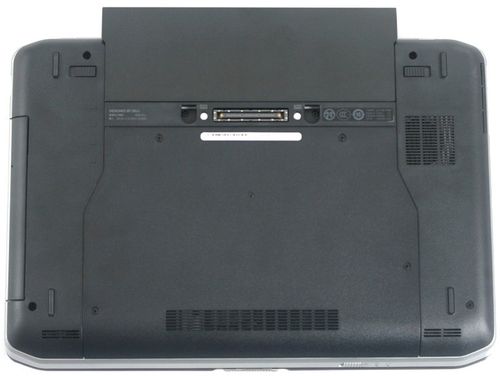Dell Latitude E5420 Review
Dell claims that even the sub-$600 Latitude E5420 business notebook is made for "durability, productivity, security and easy manageability." We'll analyze these claims against our benchmark and real-world tests to find out if this notebook deserves a spot in your office.
Build and Design
The Dell Latitude E5420's overall build quality is great. It has what Dell calls a Tri-Metal design, which includes anodized brushed aluminum in the display cover, reinforced steel hinges, and a strong magnesium alloy inside the chassis. It also has a zinc alloy screen release to keep the display firmly in place until you slide the release bar, an LCD sealant to help prevent against scratches, and a spill-resistant keyboard. This all means that the notebook should hold up against everyday mishaps, and when compared to the rest of the world's budget business notebook lineup, it's well above average. Not only that, but the build quality is way better than last year's plastic shell on the E5410.
When pressing down on the notebook below the display, keyboard, and palmrests, it budges just a bit, but not enough to cause problems. The palmrests are a little sturdier than the keyboard and upper areas. Despite the brushed aluminum inside the display, the screen does budge when bended at the corners. The rest of the display is harder to bend - it seems the corners are the main concern here. The steel hinges are tough, and hold fast when the screen is bent back and forth.
Stylistically, the E5420 has smooth matte surfaces encased in soft black and silver trimmings. The notebook looks professional and feels nice to the touch. And, the surfaces don't easily smudge up or collect dirt - a huge plus. The E5420 has a good, clean design to it.
The Dell Latitude E5420 can be upgraded easily. To reach the hard drive, memory slots and wireless network card, remove four screws and push the panel outward. Its removal can be done with little effort and it has two RAM slots for up to 8GB of memory.
Ports and Features
At this price range, the E5420 should have definitely had a USB 3.0 port or two. Other than that, this notebook has a very good port selection. It has a total of four USB 2.0 ports to connect all of the essentials, a memory card reader, VGA for an external monitor, eSATA, a SmartCard reader (optional), and HDMI. There's even a docking connector port on the bottom, and you can choose from six different types of dock stations straight from the E5420's product page. The screen release is quite tough and will secure the display from opening while traveling.
Screen and Speakers
The E5420 has an anti-glare/matte 14-inch 900p (1600 x 900 resolution) display and has great HD resolution, but below to average contrast when compared to most other business notebooks. When we measured its brightness, we found that it has a peak luminance of 295 nits and an average of 1.55 nits in the other direction, making this notebook have a contrast of 183:1, meaning, the contrast is average at best. However, the higher resolution sets it apart from other budget business notebooks.
Horizontal viewing angles are narrow; colors and images start inverting within 5 degrees of the notebook being tilted forward or backward. Vertical viewing angles are much better though; they don't start to change until 25-30 degrees. Meaning, when you sit in front of the notebook in the office you'll have to keep it tilted at just the right angle to see everything clearly (it also doesn't help that the brightness measurements were as much as 25 nits brighter in some spots than in others).
The E5420 has IDT HD audio. Oddly enough, the speakers are located underneath the notebook, which doesn't help to carry the audio up and out to the ears. The resulting effect leaves the listener feeling as though the audio is muffled. When the volume is set on a high level, there is noticeable sound distortion. But if you don't set it up high, you won't be able to hear it very well, which is a problem in and of itself. Also, there is no subwoofer, so the bass in music/other audio will be practically non-existent. If you have to do a presentation with audio for work, the notebook will probably only be suitable in smaller rooms due to the speakers' inability to carry sound across distances.
Dell Latitude E5420 Keyboard and Touchpad
The keyboard on the E5420 is a mix between a Chiclet and traditional-style. The keys are square, somewhat raised, and flat. They also have a bit of extra spacing in between to help with key travel. The tactile feedback is above average; it's both easy and comfortable to type on. It's also spill-resistant and can be configured with backlighting for use in low-lit or dark areas.
The E5420 uses an Alps Electric Dell touchpad with multi-gesture controls. It's considerably large and provides great cursor movement due to its smooth, wide surface area. It has two sets of left and right-click buttons that make hardly any noise when pressed. We have absolutely no complaints about it, this touchpad is excellent.
Performance and Benchmarks
With the combination of the second-gen Intel dual-core processor running at 2.6GHz, Intel HD graphics, and 4GB dual-channel RAM at 1333MHz, this notebook is able to breeze through everyday office tasks and then some. We watched a couple of HD 1080p videos, had several office productivity programs open, and listened to music at the same time without any problems. Generally speaking, the notebook scored about the same as most other business notebooks in this price range ($1000) in the synthetic benchmark tests.

Heat and Noise
During one of our full-system benchmark tests, we took the temperature of the E5420 and found that it reached 100 degrees Fahrenheit on the bottom-middle. It also reached 102 degrees on the right side near the optical drive. Other than those two readings, the notebook stayed around 80-97 degrees. The 102 reading is a bit higher than normal, but as long as it doesn't reach above 105 it should be fine. Whether or not it's lap-friendly is another story -- for most it won't be after a while of it sitting there.
The notebook has a few heat escapes on the bottom and an exhaust vent on the left side. When the hardware is worked hard, you can definitely hear the fan running ... but when it's running at normal capacity, it's quiet.
Battery Life
The E5420 has a 9-cell 97Wh Lithium-ion battery and a 65W power adapter. During our battery life test, we set the notebook on the Windows 7 "Balanced" power profile, turned the screen brightness down 70%, turned on the wireless and connected to a network, and refreshed a text-heavy web page every 60 seconds. The notebook was able to stay on and active for 9 hours and 20 minutes. The 9-cell battery is optional, but we highly recommend it since it can add hours to your work capacity while away from a power source.
Conclusion
We recommend Dell Latitude E5420, as it has all of the essentials that a business notebook should have: solid build quality, long-lasting battery life, a nice keyboard and touchpad, and good performance. It will be able to give you the power to stay productive in the workplace and won't run out of juice for a long time when you're away from your desk. That being said, there are a few things that this notebook should have had, such as a SuperSpeed USB 3.0 port for faster flash drive performance, better speakers, and a different fan. The fans can be heard pressing air out vigorously when the laptop is being pushed.



